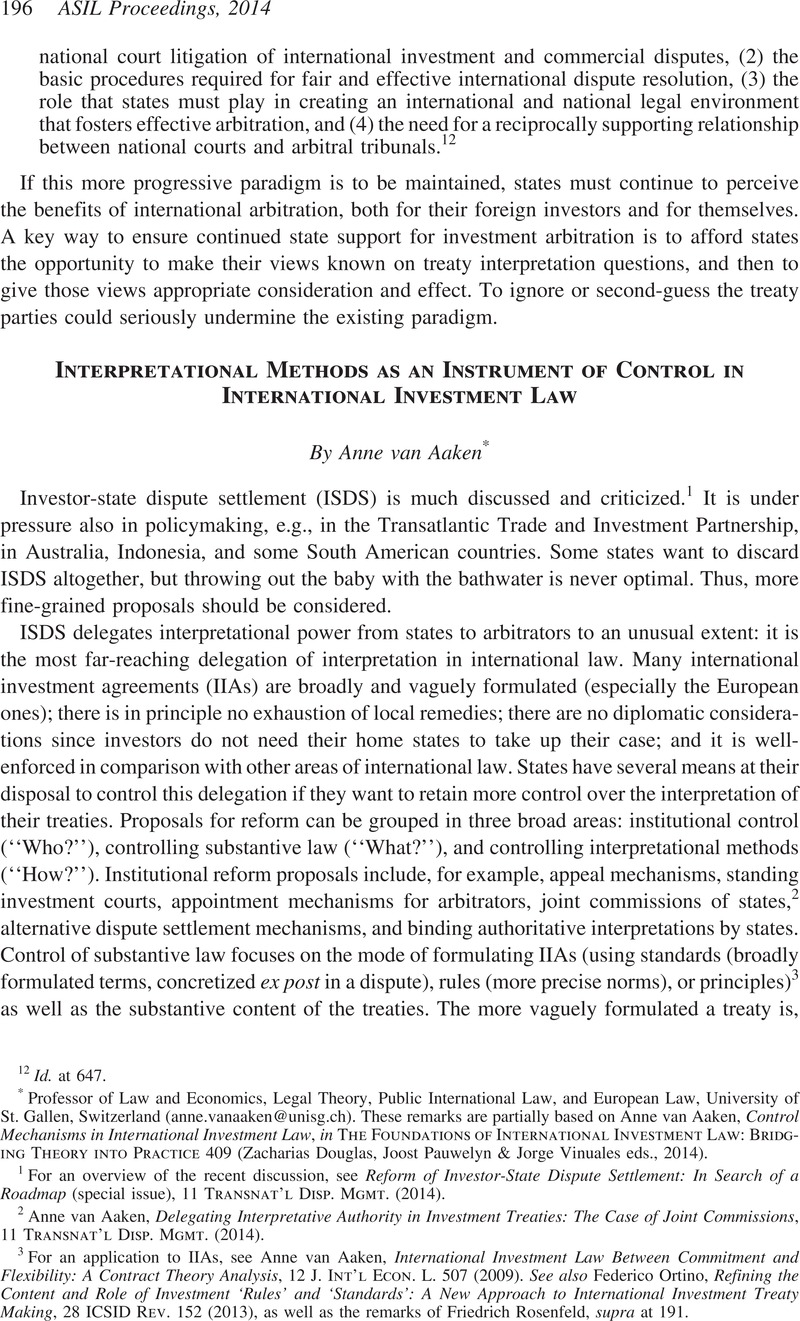Published online by Cambridge University Press: 20 January 2017

1 For an overview of the recent discussion, see Reform of Investor-State Dispute Settlement: In Search of a Roadmap (special issue), 11 Transnat’l Disp. Mgmt. (2014).
2 van Aaken, Anne, Delegating Interpretative Authority in Investment Treaties: The Case of Joint Commissions, 11 Transnat’l Disp. Mgmt. (2014)Google Scholar.
3 For an application to IIAs, see van Aaken, Anne, International Investment Law Between Commitment and Flexibility: A Contract Theory Analysis, 12 J. Int’l Econ. L. 507 (2009)CrossRefGoogle Scholar. See also Ortino, Federico, Refining the Content and Role of Investment ‘Rules’ and ‘Standards’: A New Approach to International Investment Treaty Making, 28 ICSID Rev. 152 (2013)CrossRefGoogle Scholar, as well as the remarks of Friedrich Rosenfeld, supra at 191.
4 Grimm, Dieter, Methode als Machtfaktor, in Recht und Staat der Bürgerlichen Gesellschaft 347 (Grimm, Dieter ed. 1987)Google Scholar.
5 Roberts, Anthea, Subsequent Agreements and Practice: The Battle Over Interpretive Power, in Nolte, Georg ed., Treaties and Subsequent Practice, (Oxford, Oxford University Press 2013), p. 95.Google Scholar
6 Vienna Convention on the Law of Treaties, May 23, 1969, 1155 U.N.T.S. 331.
7 Dörr, Oliver, Article 31, in Vienna Convention on the Law of Treaties: A Commentary 523 (Dörr, Oliver & Schmalenbach, Kirsten eds., 2012)CrossRefGoogle Scholar.
8 For details, see Richard K. Gardiner, Treaty Interpretation (2008).
9 “Object” (l’objet) can be read to mean the substantive content of a treaty (rights and obligations), whereas the purpose (le but) refers to the general result which the parties want to achieve. Buffard, Isabelle & Zemanek, Karl, The “Object and Purpose” of a Treaty: An Enigma?, 3 Austrian Rev. Int’l & Eur. L. 311, 318 (1998)Google Scholar (extensively reviewing jurisprudence and scholarly literature).
10 E.g., Siemens A.G. v. Argentine Rep., ICSID Case No. ARB/02/8, Decision on Jurisdiction, Aug. 3, 2004, para. 81.
11 SGS Société Générale de Surveillance SA v. Phil., ICSID Case No. ARB/02/6, Jan. 29, 2004, para. 116; Noble Ventures v. Rom., ICSID Case No. ARB/01/11, Award, Oct. 12, 2005, para. 52.
12 Cf. Jeswald W. Salacuse, The Law of Investment Treaties 114 (2010).
13 For details, see Roberts, Anthea, Subsequent Agreements and Practice: The Battle over Interpretive Power, in Treaties and Subsequent Practice 95 (Nolte, Georg ed., 2013)Google Scholar.
14 Study Group of the Int’l Law Comm’n, Fragmentation of International Law: Difficulties Arising from the Diversification and Expansion of International Law (by Koskenniemi, Martti), A/CN.4/L.682 (Apr. 13, 2006)Google Scholar.
15 van Aaken, Anne, Fragmentation of International Law: The Case of International Investment Law, 17 Fin. Y.B. Int’l L. 91 (2008)Google Scholar.
16 MacLachlan, Campbell, The Principle of Systematic Integration and Article 31(3)(c) of the Vienna Convention, 54 Int’l & Comp. L.Q. 279, 281 (2005)CrossRefGoogle Scholar.